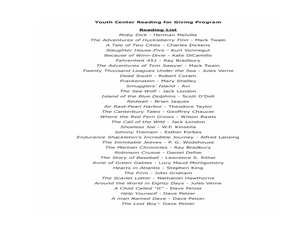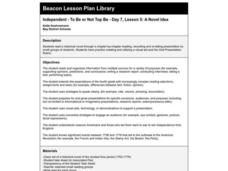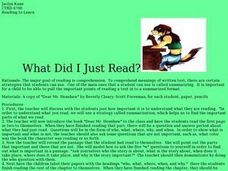College Board
Reading—Synthesis and Paired Passages
Good readers make connections between texts. The SAT regularly assesses the ability to make those connections using paired reading passages, a topic discussed in an official SAT practice lesson plan on synthesis. During the instructional...
Curated OER
Maniac Magee: The Cloze Procedure
Fill in the blanks with a Cloze activity based on Maniac Magee by Jerry Spinelli. After listening to a passage read out loud, kids complete the worksheet by using their memories and context clues.
Curated OER
Nightjohn: Directed Reading Thinking Activity
Your readers will “get to wanting” and will want to know things about Nightjohn with a DRTA activity based on Gary Paulsen’s novel. Introduce the book by asking class members to examine the cover and to make predictions about the subject...
Curated OER
CLOZE PROCEDURE for The Call of the Wild, by Jack London
An advocate of the cloze procedure to determine what learners already know about a topic? Class members listen to an excerpt from The Call of the Wild and then fill in the blanks on their cloze copy of the passage. Directions...
Aladdin Paperbacks
Running Out of Time: The Cloze Procedure
Determine if the reading level of Running Out of Time is too easy, to difficult, or just right for your pupils with a cloze reading exercise. After listening to the teacher read the passage, learners fill in the blanks on the cloze...
Curated OER
Ready-Set-Go-Whoa!
The Apaches: People of the Southwest offers readers a chance to employ the “Ready-Set-Go-Whoa!” strategy (an adaptation of the KWL) to test what they know and summarize what they learn as they read Jennifer Fleischner’s nonfiction...
Curated OER
Correctional Facility Reading
Students complete an independent reading program. In this "Reading for Giving Program" created for students in correctional facilities, students spend time reading independently and responding to the book they read. Please note: Although...
EngageNY
Mid-Unit Assessment and Discussing Themes in Esperanza Rising: (Chapter 9: "Las Ciruelas/PLums")
Give this skills-based assessment halfway through your unit on Esperanza Rising. After a brief review, class members take the test, which asks them to show that they know how to analyze the novel independently. They are asked to...
Curated OER
The Lion, the Witch, and the Wardrobe: Vocab Squares
Creatively develop and reinforce new vocabulary from the book, The Lion, the Witch, and the Wardrobe by C.S. Lewis, using these vocabulary squares. Each square is divided into four quadrants asking scholars to input the word, a...
Curated OER
A Novel Idea
Fifth graders read a historical novel. In groups they reenact chapters of the novel.
Novelinks
Nightjohn: Bloom's Taxonomy Questions
After completing Nightjohn, Gary Paulsen's young adult novel about slavery set shortly before the Civil War, readers respond to a series of questions crafted to reflect Bloom's taxonomy.
Curated OER
Parrot in the Oven: Socratic Seminar
To conclude a study of Parrot in the Oven: Mi Vida, class members sharpen their critical thinking skills by engaging in a Socratic seminar discussion of Martinez's novel.
Novelinks
The Little Prince: Blooms’ Taxonomy Questions
Question what you read with a lesson based on Bloom's Taxonomy. As kids read The Little Prince by Antoine de Saint-Exupéry, they formulate questions with cues from a graphic organizer, and answer them to work on critical...
Gourmet Curriculum Press
James and the Giant Peach
Here is a 19-page sample lesson that uses an interesting format. It starts with an appetizer or activity to make reading the book James and the Giant Peach fun. Then it dives into the main course or core content instruction which...
Curated OER
A Separate Peace: Chapter 4 Reading and Study Guide
In this A Separate Peace study guide worksheet, students define 3 vocabulary words, provide examples of 2 literary terms, and respond to 9 short answer questions regarding chapter 4 of the John Knowles novel.
Curated OER
Roll With the Punches: Oprah's On!
Sixth graders prepare questions for an Oprah Winfrey talk show featuring the characters from Roll of Thunder, Hear My Cry, the amazing novel by Mildred D. Taylor. Selected students role-play the characters and answer questions Oprah...
Curated OER
Reading for Righties and Lefties
Students choose novels to read in an open reading forum.
Curated OER
The Glass Menagerie: Anticipation Guide
Readers are introduced to the key themes in Tennessee Williams' The Glass Menagerie by this carefully crafted anticipation guide. A great discussion starter.
Brigham Young University
Socratic Seminar for Cold Sassy Tree
Tired of giving the same old multiple-choice tests, and have the urge for a new assessment? Then bring the precision of a Socratic seminar into your classroom. Even if you did not read Cold Sassy Tree the organization and explanation on...
Curated OER
Maus: Cubing Questioning Strategy
Maus is the text for a postreading activity that has class members using a cubing strategy to analyze, in depth, topics (racism, past and present, forgetting/remembering the Holocaust, representing the Holocaust) associated with Art...
Curated OER
Hatchet: Vocabulary Strategy
Want your class to use critical thinking when discussing vocabulary? Go beyond the dictionary with a vocabulary activity based on Gary Paulsen's Hatchet. Kids write the word in the center of a graphic organizer that also provides...
EngageNY
Mid-Unit Assessment: On-Demand Note-taking and Text-Dependent Questions
Flex those brain muscles! Scholars take a mid-unit assessment, conducting research to take notes about how a particular invention helped meet society's needs. To complete the test, they work on draft sketches for their graphic...
Curated OER
Out of the Dust: Questioning Strategies
Bloom's Taxonomy is a great way to address the many levels of comprehension. With explanations and examples of each level, you can create questions that focus on knowledge, comprehension, application, analysis, synthesis, and evaluation.
Curated OER
What Did I Just Read
Fourth graders write a summary for each chapter as they read a novel. They summarize the author's purpose and point of view after completing the novel. They also describe about how the author's point of view affected the novel.

























